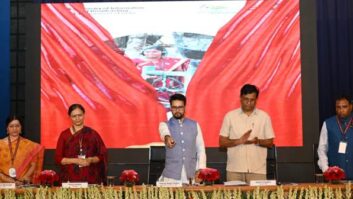
The voice from the fringe of society. The NGO KCOMNET
has been active since 2002.
NAIROBI, Kenya — Community radio in Kenya achieved a separate identity from commercial private broadcasters in 1998.
Despite being close to its target audience and readily attuned to changing tastes, it has become apparent that financial constraints might not be the sector’s only limitation, but the licensing and regulatory regime as well.
Standing outside community radio station Koch FM in downtown Nairobi, the senior producer rifles through some files.
“Here is an example,” Shiko says, “where are we supposed to get the money to pay for all these fees and penalties?”
WHERE TO BEGIN
The document that Shiko (her radio name) shows to me is a legal demand for more than 3 million Kenyan shillings (about US$30,000) in music broadcast royalty fees from one of the many emerging copyright bodies that have positioned themselves as fee collection bailiffs for musicians and theater artists.
Whereas the Music Copyright Society of Kenya used to be the only legal enforcer, court challenges, and a fractious artist fraternity have given rise to a multitude of other outfits, each of which send radio stations demand notes for the same royalties with the slim likelihood that the returns will reach the deserving recipients.

Doreen takes a break from the “Wasanii Maskani” (“Artists From the Neighborhood”) show to peek at her phone messages.
Shiko does not appear surprised or even disappointed with the contents of the document. She gives the impression that the bill will remain in the drawer for the foreseeable future.
A visit to the station deep in the informal settlements of eastern Nairobi is a tour of civic abandonment, until you reach the shipping container, acoustically padded and modified into a two-room radio studio.
Tom Mboya, the station head, is away in Arusha, Tanzania, covering the national elections. Shiko and her colleagues, all volunteers, are holding down the fort with a hint of lightheaded genial boredom. The staff of about 20, including interns, runs the station daily from 6 a.m. to midnight on a menu of community news, interactive phone-in requests, live outside events and customized programs for the 15 to 35 age demographic of about 100,000 listeners in the area.
The Kenya Community Media Network divulges that the challenges besetting community radio are huge. KCOMNET, which is run by a board of media veterans was established in 2002. Its interests encompass theater, newsletters and film, but community radio is its flagship and the focus of its efforts are stations like Koch FM.
RESTRICTIONS
NGO Coordinator Njuki Githethwa directs my attention to the Kenya Information and Communication Act, 2013, under which broadcasting regulations fall. “Look at the license allocation rules,” he said, “They are subject to the availability of frequency resources.”
One of the contentious issues of the KICA act in a delayed court case brought by the Media Owners Association of Kenya in 2014, was the apparently distorted formula of allocating frequencies. The lawsuit is expected to be adjudicated before the year’s end.
This is a consequence of the overriding first-come, first-serve principle, which many believe, has made frequency availability in commercially-viable centers a hit or miss lottery.
All frequencies are drawn from one hat, with no special allotment for community or special interest groups, explains Githethwa. After purchase, some of these frequencies are hoarded and resold openly by enterprising speculators.
“With such frequencies now going beyond the recommended fee of US$300 for special interest stations, this state of affairs feeds into the second problem afflicting community radio, Githethwa said. “They go underground, they don’t register with the government, not even with us.”
Indeed the incentive to register a community radio station recedes further when the legal requirements of submission of business and technical plans, together with tax receipts are taken into account. For stations in operation, commercial spot advertisements are prohibited. Sponsored programs are allowed, but the content must be community-centric. Radio transmission signal range should not exceed a five-kilometer radius.

Koch FM presenter Mbulo interviews events organizer Cyprian Ogode
during the program “Janjaruka” (“Arise”).
NO COMMENT
The Communications Authority of Kenya’s Tom Olwero declined comment on licensing issues, citing the forthcoming court case.
In 2004 and 2005, KCOMNET assisted established Radio Mang’elete to formally register as the first community radio. In 2006, Koch FM, Ghetto FM, Pamoja FM and Sauti Radio followed suit. Today 16 stations are registered, which is a drop in the ocean according to the organization.
Even the geographical distribution of the registered stations is stilted, with a majority in cities and urban areas, as opposed to rural areas where ironically, their services are most needed. The organization says it attempts to assist these stations by creating local content, networking and policy advocacy.
As an NGO, KCOMNET has no enforcement powers, and much of its effort is limited to advisory initiatives. Together with organizations like the Ford Foundation, UNESCO, church-based NGOs and government agencies, it organizes workshops and seminars to inculcate “journalistic values and legal concepts among presenters.”
With rapid technological changes in the communications industry, radio is finding itself falling far behind the competition. As KCOMNET points out, creating revenue streams for community radio stations appears be a difficult preoccupation with little to show for it.
“The models of income generation are unreliable,” Githethwa asserts, “the sustenance formula is unrealistic.” Corporate advertisers steer clear of the stations, the small business classifieds the stations are allowed to air, are intermittent. He explains that on programming partnerships, even donors aiding training programs return later to find the talent has been poached by commercial radio.
POSSIBLE SOLUTIONS
KCOMNET believes that as the highest budget advertiser, the state should make it a policy to channel approximately 20 percent of its advertising budget to community radio. “An advertising spend of US$5,000 quarterly for a community station goes a long way,” emphasizes Githethwa. “And it’s a win-win situation given that rural communities and low-income demographics have much higher radio loyalty than the smartphone urban gentry — thus the message will stick.”
County government incubation funds like Uwezo (for youth and women) should also be opened up to communities willing to establish radio stations, he continues, arguing that these funds create secondary avenues for employment in the form of art and music production houses whose content the stations will rely on.
Radio Mang’elete, for instance, received support from the Constituency Development Fund, which usually finances school and health-related infrastructures. “The funds are there,” says Githethwa, “but when the enabling environment and policy legislation is absent, you find an ad hoc and partisan approach in disbursing them.”
Initiatives such as these are what KCOMNET would like to see emulated, but in the final analysis, “It all boils down to the aggressiveness and resourcefulness of the communities,” says Githethwa.
Dedicated frequencies are a means to a revenue-generating end, Githethwa believes. Traditional markets are decreasing but newer, social media-enhanced programs promise high returns for what is still after all, the most popular mass dissemination platform. These opportunities have to be exploited, because only then will stations such as Koch FM be able to pay their royalty fee obligations.
Gregory Lagat, a radio program consultant, reports on the industry for Radio World from Nairobi, Kenya.










